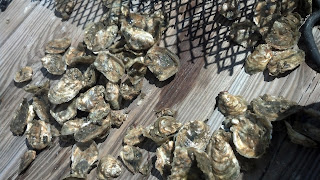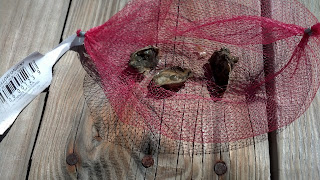Checked on the oysters today, a cool and blustery day after a front came through after dark last night. We had some Rappahannock River oysters, some Stingray Point oysters and some Old Salts yesterday at Merroir at Locklies. One delicious one had two babies on his back so I brought them home to lie in my oyster pot. I checked up on it though it has only been two weeks since the last checkup. They look fine, about 2-2.5" in size.
I also put the crab pots out just before sunset last night. Remarkably, we have seven crabs at noon the next day. Sweet red pepper and crab soup? or just pick them? This may be the last crabbing of the season, this first full day of Fall.
Sunday, September 23, 2012
Sunday, September 9, 2012
Oyster update
On Memorial Day 2011 I bought an oyster float and young oysters (spat) from oystergardner.com and secured them under my dock. They had reached about 1.5" size when Hurricane Irene struck. Although the float remained, the oysters were all gone (they were in an insert). As the package weighed at least ten pounds, I rather suspect they were stolen but in any event they were gone.
In May 2012 I bought a new bag of spat from Tom and placed them into the float. By July they had grown nicely and I moved them up to the next larger size insert. This weekend they were ready for the next larger size insert, as they had grown to 1.5-2" in size (most of them anyway). The insert plus its cargo now weighs about ten pounds--a fair amount of CO2 has been converted to calcium carbonate! Besides decreasing the atmospheric carbon load, the oysters also filter and clean the Bay. These are located at the confluence of Sturgeon Creek with the Rappahannock River, near the River's confluence with the Bay. One can see the float and the insert in the photo--a later photo of the hummingbird feeder shows the waterways flowing together to the Chesapeake Bay in the distance.
Here you can see the oysters in the old insert, which is covered in growths. There are also small crabs, worms of various kinds, sea grapes (gelatinous creatures--(Molgula manhattensis)), sea lice, shrimp, barnacles and goo. I transferred the oysters into a new insert with a larger mesh which should allow better circulation.
Here they are migrating to the new mesh insert. For scale, the boards on the pier are 6" wide. The larger oysters have already grown to about 2" in size. When this began in May they were the size of my pinky nail and all 500 fit into a tiny bag the size of my fist.
Finally they are all in, fastened and ready to go back into the drink. They had been on the beach for about two hours, recommended as although they oysters can exist happily out of water that long, some worms which are their predators cannot, so the theory is that the worms die during this time.
Now I restored them to the float for the next month or so of growth, at which point I'll bring them out again, rinse them off and wipe out another set of worms. Oops! Three smaller fellows remained in the old float. Some of the oysters didn't grow as well as others. Perhaps that is because they are crowded. I decided to put these smaller three into a separate insert, an old onion bag.
You can see how much smaller these were. In fact, there were some smaller still. We will see if they can catch up on their growth in this more commodious accommodation.
It is the end of the season for many migratory birds, so I made up a new batch of nectar for the hummingbirds after cleaning out their feeder. They may be gone the next time I get down to Slacktide.
Lastly I decided to harvest the apples. All three of them. Well, actually, only two. The best one is always just out of reach. I had one for lunch--it was delicious. The only other nearby apple tree is about 500 feet away and is in the last stage of its life, so mine didn't get much pollen this year. I need to plant another tree if I want more fruit!
In May 2012 I bought a new bag of spat from Tom and placed them into the float. By July they had grown nicely and I moved them up to the next larger size insert. This weekend they were ready for the next larger size insert, as they had grown to 1.5-2" in size (most of them anyway). The insert plus its cargo now weighs about ten pounds--a fair amount of CO2 has been converted to calcium carbonate! Besides decreasing the atmospheric carbon load, the oysters also filter and clean the Bay. These are located at the confluence of Sturgeon Creek with the Rappahannock River, near the River's confluence with the Bay. One can see the float and the insert in the photo--a later photo of the hummingbird feeder shows the waterways flowing together to the Chesapeake Bay in the distance.
Here you can see the oysters in the old insert, which is covered in growths. There are also small crabs, worms of various kinds, sea grapes (gelatinous creatures--(Molgula manhattensis)), sea lice, shrimp, barnacles and goo. I transferred the oysters into a new insert with a larger mesh which should allow better circulation.
Here they are migrating to the new mesh insert. For scale, the boards on the pier are 6" wide. The larger oysters have already grown to about 2" in size. When this began in May they were the size of my pinky nail and all 500 fit into a tiny bag the size of my fist.
Finally they are all in, fastened and ready to go back into the drink. They had been on the beach for about two hours, recommended as although they oysters can exist happily out of water that long, some worms which are their predators cannot, so the theory is that the worms die during this time.
Now I restored them to the float for the next month or so of growth, at which point I'll bring them out again, rinse them off and wipe out another set of worms. Oops! Three smaller fellows remained in the old float. Some of the oysters didn't grow as well as others. Perhaps that is because they are crowded. I decided to put these smaller three into a separate insert, an old onion bag.
You can see how much smaller these were. In fact, there were some smaller still. We will see if they can catch up on their growth in this more commodious accommodation.
It is the end of the season for many migratory birds, so I made up a new batch of nectar for the hummingbirds after cleaning out their feeder. They may be gone the next time I get down to Slacktide.
Lastly I decided to harvest the apples. All three of them. Well, actually, only two. The best one is always just out of reach. I had one for lunch--it was delicious. The only other nearby apple tree is about 500 feet away and is in the last stage of its life, so mine didn't get much pollen this year. I need to plant another tree if I want more fruit!
Subscribe to:
Posts (Atom)








